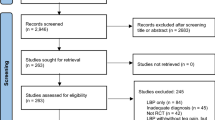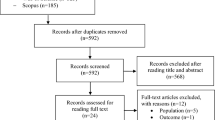Abstract
Purpose
This study reports the results of a registry data collection project within a secondary care spinal osteopathy service.
Methods
Clinical and demographic data were collected using the Spine Tango Conservative registry data collection tool. Outcomes were assessed using the Numerical Pain Rating Scale (NPRS), Oswestry Disability Index (ODI), Neck Disability Index (NDI), COMI Low Back Conservative (COMI-LBC), COMI Neck Conservative (COMI-NC) and EQ5D. Global treatment outcome (GTO), satisfaction with care and therapeutic complications were reported using the Spine Tango Patient Self Assessment form (STPSA). The correlation of GTO and PROM change scores was analysed using Spearman’s rank correlation coefficient.
Results
262 patients presented during the study period. 100% of patients had chronic spinal pain and 98.8% had previously received other interventions for the same episode. Mean (standard deviation) improvements by PROM: NPRS low back 2.1 (2.5); NPRS neck 2.3 (2.3); COMI-LBC 2.1 (2.2); COMI-NC 2.0 (1.7); ODI 10.5 (12.1); NDI 14.5 (12.2); EQ5D 0.2 (0.3). 83.2% of patients reported that osteopathy had ‘helped a lot’ or ‘helped’. 96.2% of patients were ‘very satisfied’ or ‘satisfied’ with care. There were no serious therapeutic complications.
Conclusions
The secondary care spinal osteopathy service demonstrated high satisfaction, few therapeutic complications and positive outcomes on all PROMs. Registry participation has facilitated robust clinical governance and the data support the use of osteopaths to deliver a conservative spinal service in this setting. Registry data collection is a significant administrative and clinical task which should be structured to minimise burden on patients and resources.
Graphical abstract
These slides can be retrieved under Electronic Supplementary Material.






Similar content being viewed by others
References
Kay TM, Myers AM, Huiljbregts MP (2001) How far have we come since 1992? A comparative survey of physiotherapists’ use of outcome measures. Physiother Can 53(4):268–275
Department of Health (2000) The NHS Plan. A plan for investment. A plan for reform. The Stationery Office Ltd, London
Department of Health (2010) Equity and excellence: liberating the NHS. The Stationery Office Ltd., London (ISBN 978010178812)
Timmins N (2008) Assessing patient care: NHS goes to the PROMS. BMJ 28336(7659):1464–1465
Duncan E, Murray J (2012) The barriers and facilitators to routine outcome measurement by allied health professionals in practice: a systematic review. BMC Health Serv Res 12:96
Dagenais S, Caro J, Haldeman S (2008) A systematic review of low back pain cost of illness studies in the United States and internationally. Spine J 8:8–20
Hoy D, March L, Brooks P et al (2014) The global burden of low back pain: estimates from the Global Burden of Disease 2010 study. Ann Rheum Dis 73(6):968–974
Hoy D, March L, Woolf A et al (2014) The global burden of neck pain: estimates from the Global Burden of Disease 2010 study. Ann Rheum Dis 73(6):982–989
Last A, Hulbert K (2009) Chronic low back pain: evaluation and management. Am Fam Phys 79(12):1067–1074
Van Hoof M et al (2015) Evidence and practice in spine registries: a systematic review, and recommendations for the future design of registries. Acta Orthop 86(5):534–544
Chou R, Huffman LH (2007) Nonpharmacologic therapies for acute and chronic low back pain: a review of the evidence for an American Pain Society/American College of Physicians Clinical Practice Guideline. Ann Intern Med 147:492–504
Standaert C, Friedly J, Erwin M, Lee M, Rechtine G, Henrikson N, Norvell D (2011) Comparative effectiveness of exercise, acupuncture and spinal manipulation for low back pain. Spine 36:S120–S130
O’Keeffe M, Purtill H, Kennedy N, Conneely M, Hurley J, O’Sullivan P, Dankaerts W, O’Sullivan K (2016) Comparative effectiveness of conservative interventions for nonspecific chronic spinal pain: physical, behavioral/psychologically informed, or combined? A systematic review and meta-analysis. J Pain 17(7):755–774. https://doi.org/10.1016/j.jpain.2016.01.473
Ibrahim T, Tleyjeh IM, Gabbar O (2008) Surgical versus non-surgical treatment of chronic low back pain: a meta-analysis of randomised trials. Int Orthop 32(1):107–113
Dawson J, Doll H, Fitzpatrick R, Jenkinson C, Carr A (2010) The routine use of patient reported outcome measures in healthcare settings. BMJ 340:c186
McGirt MJ, Speroff T, Dittus RS, Harrell FE Jr, Asher AL (2013) The National Neurosurgery Quality and Outcomes Database (N2QOD): general overview and pilot-year project description. Neurosurg Focus 34(1):E6. https://doi.org/10.3171/2012.10.FOCUS12297
Cochrane A (1989) Archie Cochrane in his own words. Control Clin Trials 10:428–433
Malmivaara A (2016) Clinical impact research—how to choose experimental or observational intervention study? Ann Med 48(7):492–495. https://doi.org/10.1080/07853890.2016.1186828
Röder C, Müller U, Aebi M (2006) The rationale for a spine registry. Eur Spine J 15(Suppl 1):S52–S56
Breakwell LM (2013) Understanding the need for spinal registries: Lee Breakwell reviews the importance of registries in spinal research and explains why the British Association of Spinal Surgeons (BASS) has decided to set up its own registry. Eur Spine J 22(Suppl 1):S5–S6. https://doi.org/10.1007/s00586-013-2666-z
Kessler J, Melloh M, Aghayev E, Röder C (2011) Development of a documentation instrument for the conservative treatment of spinal disorders in the International Spine Registry Spine Tango. Eur Spine J 20(3):369–379
Röder C, Staub L, Dietrich D, Zweig T, Melloh M, Aebi M (2009) Benchmarking with Spine Tango: potentials and pitfalls. Eur Spine J 18(Suppl 3):S305–S311
National Spinal Taskforce (2013) Commissioning spinal services—getting the service back on track: a guide for commissioners of spinal services. http://www.nationalspinaltaskforce.co.uk/pdfs/NHSSpinalReport_vis7%2030.01.13.pdf. Accessed 12 Dec 2016
Morris S, Booth J, Hegarty J (2016) Spine Tango registry data collection in a conservative spinal service: a feasibility study. Eur Spine J 25(9):2984–2992. https://doi.org/10.1007/s00586-016-4697-8
Fairbank JCT, Pynsent PB (2000) The Oswestry Disability Index. Spine 25:2940–2953
EuroQol Group (1990) EuroQol—a new facility for the measurement of health-related quality of life. Health Policy 16(3):199–208
Lozano-Alvarez C, Perez-Prieto D, Salo G, Molina A, Llado A, Ramırez M (2012) Usefulness of the core outcome measures index in daily clinical practice for assessing patients with degenerative lumbar disease. Adv Orthop. https://doi.org/10.1155/2012/474685
Fankhauser CD, Mutter U, Aghayev E, Mannion AF (2012) Validity and responsiveness of the Core Outcome Measures Index (COMI) for the neck. Eur Spine J 21(1):101–114
Vernon H, Mior S (1991) The Neck Disability Index: a study of reliability and validity. J Manip Physiol Ther 14(7):409–415
Mannion AF, Elfering A, Staerkle R, Junge A, Grob D, Semmer NK, Jacobshagen N, Cvorak J, Boos N (2005) Outcome assessment in low back pain: how low can you go? Eur Spine J 14:1014–1026
Nelson E, Dixon-Woods M, Batalden P, Homa K, Van Citters A et al (2016) Patient focused registries can improve health, care, and science. BMJ 354:i331. https://doi.org/10.1136/bmj.i3319
Zweig T, Enke J, Mannion AF, Sobottke R, Mellow M, Freeman B, Aghayev E (2017) Is the duration of pre-operative conservative treatment associated with the clinical outcome following surgical decompression for lumbar spinal stenosis? A study based on the Spine Tango Registry. Eur Spine J 26(2):488–500
Becker HJ, Nauer S, Porchet F et al (2017) A novel use of the Spine Tango registry to evaluate selection bias in patient recruitment into clinical studies: an analysis of patients participating in the Lumbar Spinal Stenosis Outcome Study (LSOS). Eur Spine J 26(2):441–449
Maniadakis N, Gray A (2000) The economic burden of back pain in the UK. Pain 84:95–103
da Menezes Costa L, Maher CG, Hancock MJ, McAuley JH, Herbert RD, Costa LOP (2012) The prognosis of acute and persistent low-back pain: a meta-analysis. CMAJ 184(11):E613–E624. https://doi.org/10.1503/cmaj.111271
Chapman J, Norvell D, Hermsmeyer J, Bransford R, DeVine J, McGirt M, Lee M (2011) Evaluating common outcomes for measuring treatment success for chronic low back pain. Spine 36(Suppl 21):S54–S68
Mannion AF, Porchet F, Kleinstück FS, Lattig F, Jeszenszky D, Bartanusz V, Dvorak J, Grob D (2009) The quality of spine surgery from the patient’s perspective: Part 2. Minimal clinically important difference for improvement and deterioration as measured with the Core Outcome Measures Index. Eur Spine J 18(Suppl 3):S374–S379
Yelland M, Schluter P (2006) Defining worthwhile and desired responses to treatment of chronic low back pain. Pain Med 7(1):39–45
Crosby RD, Kolotkin RL, Williams GR (2003) Defining clinically meaningful change in health-related quality of life. J Clin Epidemiol 56(5):395–407
Licciardone J, Aryal S (2014) Clinical response and relapse in patients with chronic low back pain following osteopathic manual treatment: results from the OSTEOPATHIC Trial. Man Ther 19(6):541–548. https://doi.org/10.1016/j.math.2014.05.012
O’Sullivan P (2005) Diagnosis and classification of chronic low back pain disorders: maladaptive movement and motor control impairments as underlying mechanism. Man Ther 10:242–255
Aghayev E, Sobottke R, Munting E, Pigott T, Perler G, Zweig T, Luca A, Mannion AF (2015) The international Spine Registry Spine Tango: annual report 2015. Eurospine. http://www.eurospine.org/cm_data/Spine_Tango_Report_International_2015_19_9_16.pdf Accessed 29 Oct 17
World Health Organization (2004) ICD-10: international statistical classification of diseases and related health problems. World Health Organization, Geneva
van Hooff ML, Mannion AF, Staub LP et al (2016) Determination of the Oswestry Disability Index score equivalent to a “satisfactory symptom state” in patients undergoing surgery for degenerative disorders of the lumbar spine—a Spine Tango registry-based study. Spine J 16(10):p1221–p1230
Vogel S, Mars T, Keeping S, Barton T, Marlin N, Froud R, Eldridge S, Underwood M, Pincus T (2013) Clinical risk osteopathy and management scientific report: the CROaM study. http://www.osteopathy.org.uk/uploads/croam_full_report_0313.pdf. Accessed 03 Nov 2017
Copay AG, Subach BR, Glassman SD, Polly DW Jr, Schuler TC (2007) Understanding the minimum clinically important difference: a review of concepts and methods. Spine J 7(5):541–546
Author information
Authors and Affiliations
Corresponding author
Ethics declarations
Conflict of interest
None of the authors has any potential conflict of interest.
Electronic supplementary material
Below is the link to the electronic supplementary material.
Rights and permissions
About this article
Cite this article
Morris, S., Booth, J. Shaping conservative spinal services with the Spine Tango Registry. Eur Spine J 27, 543–553 (2018). https://doi.org/10.1007/s00586-018-5484-5
Received:
Accepted:
Published:
Issue Date:
DOI: https://doi.org/10.1007/s00586-018-5484-5




